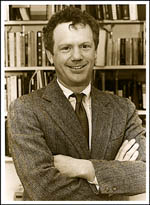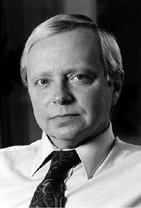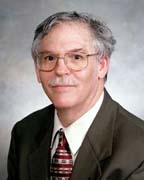Dr. Robert Kirshner, Associate Director, Harvard-Smithsonian Center for Astrophysics
Dr. Harvey Tananbaum, Director, Chandra X-ray Center
Dr. Edward J. Weiler, Associate Administrator for Space Science, NASA
Dr. Martin C. Weisskopf, Project Scientist, Chandra X-ray Observatory
DR. ROBERT KIRSHNER
ASSOCIATE DIRECTOR, HARVARD-SMITHSONIAN CENTER FOR ASTROPHYSICS

Robert Kirshner is Professor of Astronomy at Harvard University and an Associate Director of the Harvard-Smithsonian Center for Astrophysics. He graduated from Harvard College in 1970 and received a Ph.D. in astronomy at Caltech four years later. After a postdoc at Kitt Peak National Observatory in Tucson, he joined the faculty at the University of Michigan for 9 years before moving to the Harvard Astronomy Department in 1986. He served as Chairman of the department from 1990-1997.
Professor Kirshner is an author of 200 research papers dealing with supernovas, the large-scale distribution of galaxies, and the size and shape of the universe. His recent work on the acceleration of the universe was dubbed the "Science Breakthrough of the Year for 1998" by Science Magazine. An article by Kirshner and his collaborators on this topic appears in the January 1999 Scientific American. He was elected to the National Academy of Sciences in 1998.
Kirshner is a frequent public lecturer on science, including the 1997 Princeton University lectures, the 1998 Seyfert Lecture at Vanderbilt University, and a featured talk to the National Science Teachers Association at their national meeting in 1999. He is also the teacher of Science A-35, a core curriculum course for 250 Harvard undergraduates entitled "Matter in the universe." The vivid (and slightly hazardous) demonstrations in Science A-35 led to Kirshner's being featured in Boston Magazine in their October 1998 article on "Nutty Professors". Kirshner has made a series of video tapes on "Cosmic Questions" for The Teaching Company which are widely available.
TopDR. HARVEY TANANBAUM
DIRECTOR, CHANDRA X-RAY CENTER

Dr. Harvey Tananbaum is director of the Smithsonian Astrophysical Observatory's Chandra X-ray Center (CXC). In this capacity he is responsible for overseeing the operation of the Chandra X-ray Observatory and providing support to the scientific users of the observatory.
Tananbaum graduated from Yale University in 1964. After receiving his Ph.D. in physics from MIT in 1968, he joined American Science & Engineering where he became project scientist for NASA's Uhuru X-ray Satellite. In 1973 he moved to the Harvard-Smithsonian Center for Astrophysics. The launch and operation of the Chandra Observatory will be the culmination of a 23 year journey for Tananbaum, who has been involved with the Chandra project from the beginning. In 1976, he and Riccardo Giacconi submitted a proposal letter to NASA to initiate the study and design of a large X-ray telescope. In 1977, work was begun on the project, which was then known as the Advanced X-ray Astrophysics Facility (AXAF). In 1998, AXAF was renamed the Chandra X-ray Observatory.
Tananbaum has been working in X-ray astronomy since his graduate days at MIT. His thesis research was on a mysterious type of cosmic X-ray source. Later, when he was project scientist for the Uhuru X-ray Satellite, observations by the satellite were instrumental in showing that this source was due to matter falling into a black hole. Tananbaum was the scientific program manager for the Einstein Observatory, the first large imaging X-ray telescope. In 1981 he became Associate Director for High Energy Astrophysics at the Harvard-Smithsonian Center for Astrophysics, a position he held for 12 years. In 1991, he was appointed director of the CXC.
Tananbaum received the NASA Exceptional Scientific Achievement Medal in 1980, and the NASA Public Service Award in 1988. He is a fellow of the American Association for the Advancement of Science, and has served as vice-president of the American Astronomical Society, as well as on numerous NASA advisory committees.
TopDR. EDWARD J. WEILER
ASSOCIATE ADMINSTRATOR FOR SPACE SCIENCE, NASA

In November 1998 Dr. Edward J. Weiler was appointed as NASA's Associate Administrator for Space Science. In this capacity, Weiler is responsible for providing overall executive leadership of NASA's Space Science Enterprise. This enterprise aims to achieve a comprehensive understanding of the origins and evolution of the Solar System and the universe, including connections between the Sun and the Earth, the beginnings of life and the question of whether life exists elsewhere beyond Earth. It also is charged with communicating this knowledge to the public.
Weiler was appointed as Science Director of the Astronomical Search for Origins and Planetary Systems theme within the Office of Space Science in March 1996. He will continue to serve as the Program Scientist for the Hubble Space Telescope, a position he has held since 1979, until a replacement for that position is selected. Weiler joined NASA in 1978 as a staff scientist.
Prior to that, Weiler was a member of the Princeton University research staff and was based at NASA'S Goddard Space Flight Center, Greenbelt, MD, as the director of science operations of the Orbiting Astronomical Observatory-3 (COPERNICUS). Weiler received his Ph.D. in astrophysics from Northwestern University in January 1976. He has published over 20 papers in the scientific journals. Dr. Weiler has received numerous awards, including the NASA Outstanding Leadership Medal and the 1994 Presidential Rank Award of Meritorious Executive for his work on HST.
TopDR. MARTIN C. WEISSKOPF
PROJECT SCIENTIST, CHANDRA X-RAY OBSERVATORY

Dr. Martin C. Weisskopf is Project Scientist for NASA's Chandra X-ray Observatory and Chief Scientist for X-ray Astronomy at NASA's Marshall Space Flight Center in Huntsville, Ala.
NASA's Chandra X-ray Observatory, the world's most powerful X-ray telescope, will help scientists understand the structure and evolution of the universe.
Weisskopf began his post-graduate career at Columbia University in 1969, where he became an assistant professor and performed many pioneering experiments in X-ray astronomy including helping to write the proposal for what was to become the Einstein Observatory, the forerunner to the Chandra X-ray Observatory. In 1977, Weisskopf left Columbia to become senior X-ray astronomer at Marshall Center and Chandra X-ray Observatory Project Scientist. In this capacity he is responsible for the scientific integrity of the Chandra X-ray Observatory.
Weisskopf has held numerous special appointments during his career. He is a Senior Co-investigator of the European Space Agency's international X-ray imaging experiment, called IBIS, and holds a similar position for an experiment to fly on the SPECTRUM-X mission being developed for X-ray study by the Russian Space Research Institute. He is Principal Investigator of a major experimental research program initiated in 1978 that currently concentrates on the development of X-ray optics.
He has served on numerous committees, including the National Academy of Science's Panel on High-Energy Astrophysics from Space, Astronomy and Astrophysics Survey Committee. He is a member of the American Astronomical Society High-Energy Astrophysics Division; the American Association for the Advancement of Science; the International Astronomical Union; Sigma Xi, a scientific research society; Phi Beta Kappa, the National Honor Society and a Fellow of the American Physical Society Astrophysics Division.
Weisskopf is the recipient of numerous awards, including the NASA Medal for Exceptional Service. He is author or co-author of 171 journal articles, books, monographs and papers in conference proceedings.
In 1964, he received his bachelor's degree with honors in physics from Oberlin College in Cleveland, Ohio, and in 1969 received his doctorate in physics from Brandeis University in Waltham, Mass.
Top

